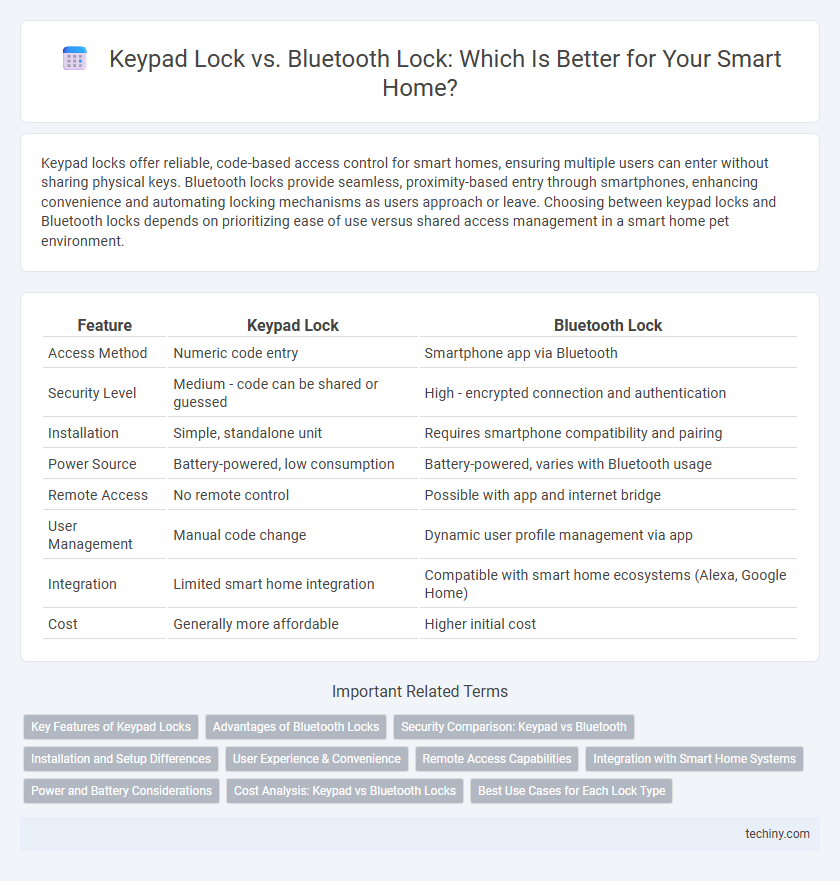Keypad locks offer reliable, code-based access control for smart homes, ensuring multiple users can enter without sharing physical keys. Bluetooth locks provide seamless, proximity-based entry through smartphones, enhancing convenience and automating locking mechanisms as users approach or leave. Choosing between keypad locks and Bluetooth locks depends on prioritizing ease of use versus shared access management in a smart home pet environment.
Table of Comparison
| Feature | Keypad Lock | Bluetooth Lock |
|---|---|---|
| Access Method | Numeric code entry | Smartphone app via Bluetooth |
| Security Level | Medium - code can be shared or guessed | High - encrypted connection and authentication |
| Installation | Simple, standalone unit | Requires smartphone compatibility and pairing |
| Power Source | Battery-powered, low consumption | Battery-powered, varies with Bluetooth usage |
| Remote Access | No remote control | Possible with app and internet bridge |
| User Management | Manual code change | Dynamic user profile management via app |
| Integration | Limited smart home integration | Compatible with smart home ecosystems (Alexa, Google Home) |
| Cost | Generally more affordable | Higher initial cost |
Key Features of Keypad Locks
Keypad locks offer keyless entry through a numeric code, enhancing home security with customizable access permissions and easy code management. They provide reliable durability, often featuring tamper alarms and weather-resistant materials suitable for both indoor and outdoor use. Keypad locks eliminate the need for physical keys, reducing the risk of lost or stolen keys while allowing temporary or permanent user codes for controlled access.
Advantages of Bluetooth Locks
Bluetooth locks offer seamless keyless entry by connecting directly to smartphones, eliminating the need for physical keys or PIN codes used in traditional keypad locks. These locks provide enhanced security through encrypted wireless communication and can be remotely managed via mobile apps for real-time access control and monitoring. Integration with smart home ecosystems enables automation and voice control, increasing convenience and flexibility compared to standalone keypad lock systems.
Security Comparison: Keypad vs Bluetooth
Keypad locks offer robust security with encrypted PIN codes and resist hacking attempts through physical barriers and code complexity. Bluetooth locks rely on encrypted wireless communication and multi-factor authentication but may be vulnerable to signal interference or hacking if firmware is outdated. Both lock types require regular software updates to maintain strong security against evolving cyber threats in smart home systems.
Installation and Setup Differences
Keypad locks generally require wiring to the existing door frame or batteries with straightforward mounting, making installation viable for most standard doors without professional tools. Bluetooth locks emphasize wireless setup through smartphone apps, enabling quick pairing and configuration without mechanical adjustments or drilling. Both systems offer user-friendly setups, but keypad locks often demand more physical installation effort, while Bluetooth locks prioritize digital connectivity ease.
User Experience & Convenience
Keypad locks offer precise entry control with customizable PIN codes, enhancing user convenience by eliminating the need for physical keys. Bluetooth locks enable seamless smartphone integration, allowing remote access and real-time notifications for improved user experience. Both options enhance smart home security, but Bluetooth locks excel in connectivity-driven convenience and hands-free operation.
Remote Access Capabilities
Keypad locks generally offer remote access through integration with smart home hubs, allowing users to control entry codes and monitor access from a smartphone app. Bluetooth locks provide direct remote access by connecting to a mobile device within proximity, enabling quick unlocking without the need for internet connectivity. For extended remote management beyond Bluetooth range, keypad locks paired with Wi-Fi adapters offer more robust remote control features.
Integration with Smart Home Systems
Keypad locks generally offer straightforward integration with most smart home systems through Wi-Fi or Z-Wave protocols, enabling remote access and customizable entry codes. Bluetooth locks excel in proximity-based control, often requiring a paired smartphone for seamless operation but may have limited compatibility with broader smart home ecosystems. Selecting between the two depends on the desired level of system integration and user convenience within the smart home's connectivity framework.
Power and Battery Considerations
Keypad locks often use replaceable batteries that can last up to a year, providing reliable power without frequent charging, while Bluetooth locks typically rely on rechargeable batteries requiring regular charging to maintain connectivity. Keypad locks offer consistent performance without concerns over wireless interference affecting power consumption. Bluetooth locks may drain faster due to continuous wireless communication, making battery management crucial for uninterrupted smart home security.
Cost Analysis: Keypad vs Bluetooth Locks
Keypad locks typically have a lower upfront cost, ranging from $50 to $150, compared to Bluetooth locks, which can cost between $100 and $250 due to advanced connectivity features. Maintenance expenses for Bluetooth locks may include occasional software updates and battery replacements, whereas keypad locks generally require minimal upkeep aside from battery changes. Considering long-term value, Bluetooth locks offer enhanced security and remote access capabilities, potentially justifying their higher price point for smart home integration.
Best Use Cases for Each Lock Type
Keypad locks offer reliable access control for homes with multiple users or frequent guests, allowing customized PIN codes without the need for a smartphone. Bluetooth locks are ideal for tech-savvy users seeking seamless, app-based entry with remote control and integration into comprehensive smart home systems. Both lock types enhance security but cater to different lifestyle preferences and connectivity requirements.
Keypad Lock vs Bluetooth Lock Infographic

 techiny.com
techiny.com